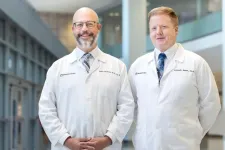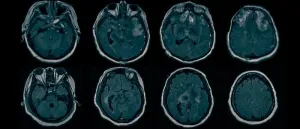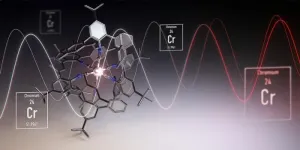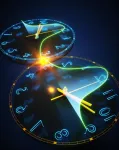(Press-News.org) CLEVELAND: A first-in-human trial of deep brain stimulation (DBS) for post-stroke rehabilitation patients by Cleveland Clinic researchers has shown that using DBS to target the dentate nucleus – which regulates fine-control of voluntary movements, cognition, language, and sensory functions in the brain – is safe and feasible.
The EDEN trial (Electrical Stimulation of the Dentate Nucleus for Upper Extremity Hemiparesis Due to Ischemic Stroke) also shows that the majority of participants (nine out of 12) demonstrated improvements in both motor impairment and function. Importantly, the study found that participants with at least minimal preservation of distal motor function at enrollment showed gains that almost tripled their initial scores.
Published in Nature Medicine, these findings build on more than a decade of preclinical work led by principal investigators Andre Machado, M.D., Ph.D., and Kenneth Baker, Ph.D., at Cleveland Clinic.
“These are reassuring for patients as the participants in the study had been disabled for more than a year and, in some cases, three years after stroke. This gives us a potential opportunity for much needed improvements in rehabilitation in the chronic phases of stroke recovery,” said Dr. Machado, chair of Cleveland Clinic’s Neurological Institute. “The quality-of-life implications for study participants who responded to therapy have been significant.”
Dr. Machado patented the DBS method in stroke recovery. Boston Scientific owns a license to those patents and provided the Vercise DBS systems used in the trial. In 2010, Cleveland Clinic Innovations established Enspire DBS Therapy, Inc., a Cleveland Clinic portfolio company and is commercializing technology developed at Cleveland Clinic to commercialize the method and it co-funded the study. Dr. Machado holds stock options and equity ownership rights with Enspire and serves as the chief scientific officer.
“We saw patients in the study regain levels of function and independence they did not have before enrolling in the research,” Dr. Machado said. “This was a smaller study and we look forward to expanding as we have begun the next phase.”
The completed EDEN trial enrolled 12 individuals with chronic, moderate-to-severe hemiparesis of the upper extremity as a result of a unilateral middle cerebral artery stroke 12-to-36 months prior. There were no major complications throughout the study. Nine of the 12 participants improved to a degree that is considered meaningful in stroke rehabilitation.
Each participant underwent DBS surgery, which involved the surgical implantation of electrodes into a part of the brain called the cerebellum. Once connected to a pace-maker-like device, the electrodes were used to deliver small electric pulses to help people recover control of their movements. Following discharge and recovery from the surgery, participants completed months of physical therapy, first with the DBS device turned off for several weeks and then turned on for four-to-eight months. It was after turning the device on that the most significant improvements were observed.
“The safety and feasibility data from this early study combined with the potential symptom improvements certainly support the need for additional, larger trials to see if cerebellar DBS is indeed a potential treatment for post-stroke motor impairment,” said Brooks Gross, Ph.D., program director, National Institute of Neurological Disorders and Stroke.
Stroke is the leading cause of long-term disabilities. Approximately 800,000 people in the United States alone suffer strokes every year. While the majority of patients will survive the acute phase, persistent neurological issues likely will jeopardize quality of life and productivity, with approximately 50% of survivors still exhibiting disability severities that require assistance with daily activities.
“There are currently no effective methods to improve the outcomes of physical rehabilitation for the hundreds of thousands of stroke survivors,” said Dr. Baker, Cleveland Clinic Lerner Research Institute. “The results of the study found that deep brain stimulation, paired with physical therapy, improved movement in patients who were more than a year out from their stroke and whose motor improvements had largely plateaued. This tells us the research warrants further investigation in larger patient samples.”
Research reported in this press release was supported by the NIH Brain Research Through Advancing Innovative Neurotechnologies® Initiative, or The BRAIN Initiative®, under award number UH3NS100543. The study was also supported by Enspire DBS Therapy, Inc.
About Cleveland Clinic
Cleveland Clinic is a nonprofit multispecialty academic medical center that integrates clinical and hospital care with research and education. Located in Cleveland, Ohio, it was founded in 1921 by four renowned physicians with a vision of providing outstanding patient care based upon the principles of cooperation, compassion and innovation. Cleveland Clinic has pioneered many medical breakthroughs, including coronary artery bypass surgery and the first face transplant in the United States. Cleveland Clinic is consistently recognized in the U.S. and throughout the world for its expertise and care. Among Cleveland Clinic’s 77,000 employees worldwide are more than 5,658 salaried physicians and researchers, and 19,000 registered nurses and advanced practice providers, representing 140 medical specialties and subspecialties. Cleveland Clinic is a 6,699-bed health system that includes a 173-acre main campus near downtown Cleveland, 23 hospitals, more than 275 outpatient facilities, including locations in northeast Ohio; southeast Florida; Las Vegas, Nevada; Toronto, Canada; Abu Dhabi, UAE; and London, England. In 2022, there were 12.8 million outpatient encounters, 303,000 hospital admissions and observations, and 270,000 surgeries and procedures throughout Cleveland Clinic’s health system. Patients came for treatment from every state and 185 countries. Visit us at clevelandclinic.org. Follow us at twitter.com/ClevelandClinic. News and resources available at newsroom.clevelandclinic.org.
Editor’s Note: Cleveland Clinic News Service is available to provide broadcast-quality interviews and B-roll upon request.
END
Cleveland Clinic study shows deep brain stimulation encouraging for stroke patients
First in-human trial phase one results published in Nature Medicine
2023-08-14
ELSE PRESS RELEASES FROM THIS DATE:
How our tastes influence our creativity
2023-08-14
What drives us to develop new ideas rather than settling for standard methods and processes? What triggers the desire to innovate at the risk of sacrificing time, energy, and reputation for a resounding failure? Creativity is based on complex mechanisms that we are only beginning to understand and in which motivation plays a central role. But pursuing a goal is not enough to explain why we favor some ideas over others and whether that choice benefits the success of our actions.
"Creativity can be defined as the ability to produce original ...
Inoue receives funding for group digital gaming: Experiences of older adults living with dementia in an activity for cognitive impairment
2023-08-14
Megumi Inoue, Associate Professor, Social Work, received funding for: "Group Digital Gaming: Experiences of Older Adults Living with Dementia in an Activity for Cognitive Impairment."
The purpose of this study is to examine the effects of a group digital gaming intervention on cognitive function, mood, and behaviors in people with early to moderate levels of dementia. A group digital gaming company, called Obie Technology, was developed to facilitate cognitive stimulation, physical exercise, and group interactions simultaneously. ...
IIR researchers receive funding for conference focused on refugee resettlement and STEM education
2023-08-14
James C. Witte, Professor, Sociology, Director, Institute for Immigration Research (IIR), and Michelle S. Dromgold-Sermen, Assistant Director, IIR, received funding for: "Refugee Resettlement and STEM Education."
This conference will focus on how STEM-oriented educational opportunities through high schools, registered apprenticeships, community college, and four-year institutions can all play a significant role in addressing urgent humanitarian needs, while also expanding the nation’s STEM workforce.
Participants will learn about the current refugee situation, how the Welcome Corps is a valuable addition to U.S. refugee ...
New study charts exposure to SARS-CoV-2 infection in Canada throughout the pandemic
2023-08-14
Most people in Canada now have hybrid immunity against SARS-CoV-2 through a mix of infection and vaccination, new research in CMAJ (Canadian Medical Association Journal) shows.
VIEW EMBARGOED ARTICLE
Using pan-Canadian blood sample data from a subset of studies backed by the COVID-19 Immunity Task Force (CITF), researchers from the CITF, in collaboration with those from supported studies, estimated changing levels of seroprevalence — from infection or vaccination, or both — over 3 time periods: prevaccination (March to November 2020), vaccine roll-out (December 2020 to November 2021) and the Omicron waves (December 2021 to March 2023). In the first 2 phases, seroprevalence from ...
Source of hidden consciousness in ‘comatose’ brain injury patients found
2023-08-14
NEW YORK, NY (Aug. 14, 2023)--Columbia researchers have identified brain injuries that may underlie hidden consciousness, a puzzling phenomenon in which brain-injured patients are unable to respond to simple commands, making them appear unconscious despite having some level of awareness.
“Our study suggests that patients with hidden consciousness can hear and comprehend verbal commands, but they cannot carry out those commands because of injuries in brain circuits that relay instructions from the brain to the muscles,” says study leader Jan Claassen, MD, associate professor of neurology at Columbia University Vagelos College of Physicians ...
Publicly fund nonsurgical procedures for transgender, gender diverse people
2023-08-14
Publicly fund nonsurgical procedures for transgender, gender diverse people
To support transgender and gender-diverse people, governments should consider publicly funding hair removal and other minimally invasive procedures, authors argue in a commentary in CMAJ (Canadian Medical Association Journal).
VIEW EMBARGOED ARTICLE
“Minimally invasive procedures such as hair removal and facial injectables may support the process of transition in a timely fashion; evidence supports their therapeutic benefits in the field of gender-affirming care,” write Drs. Katie Ross and Sarah Fraser, Faculty of Medicine, Dalhousie University, Halifax, Nova Scotia.
The ...
Chromium replaces rare and expensive noble metals
2023-08-14
Expensive noble metals often play a vital role in illuminating screens or converting solar energy into fuels. Now, chemists at the University of Basel have succeeded in replacing these rare elements with a significantly cheaper metal. In terms of their properties, the new materials are very similar to those used in the past.
We’re familiar with chromium from everyday applications such as chromium steel in the kitchen or chrome-plated motorcycles. Soon, however, the element may also be found in the screens of ubiquitous mobile phones or used to convert solar energy. Researchers led ...
No longer ships passing in the night: these electromagnetic waves had head-on collisions
2023-08-14
NEW YORK, August 14, 2023 — A research team at the Advanced Science Research Center at the CUNY Graduate Center (CUNY ASRC) has shown that it is possible to manipulate photons so that they can collide, interacting in new ways as they cross paths. The discovery, detailed in Nature Physics, will allow scientists who develop technologies rooted in electromagnetic wave propagation to make significant advances in telecommunications, optical computing and energy applications.
The breakthrough took place in the lab of Andrea Alù, Distinguished ...
Comparison of particulate air pollution from different emission sources and incident dementia
2023-08-14
About The Study: In this nationally representative study, higher residential levels of fine particulate matter were associated with greater rates of incident dementia, especially for fine particulate matter generated by agriculture and wildfires. These findings also indicate that intervening on key emission sources might have value, although more research is needed to confirm these findings.
Authors: Boya Zhang, Ph.D., of the University of Michigan School of Public Health in Ann Arbor, is the corresponding ...
Socioeconomic adversity and weight gain during the pandemic
2023-08-14
About The Study: In a large, demographically diverse sample of U.S. youth researchers found significantly greater increases in body mass index over time in 10- to 12-year-old youth assessed during the COVID-19 pandemic, compared with pre-pandemic controls. The effects of the pandemic on weight gain were most pronounced in low-income youth, suggesting that the pandemic exacerbated preexisting social inequalities.
Authors: Elizabeth Sowell, Ph.D., of Children’s Hospital Los Angeles, is the corresponding author.
To access the embargoed study: Visit our For The Media website at this link https://media.jamanetwork.com/
(doi:10.1001/jamapediatrics.2023.2823)
Editor’s ...
LAST 30 PRESS RELEASES:
Injectable breast ‘implant’ offers alternative to traditional surgeries
Neuroscientists devise formulas to measure multilingualism
New prostate cancer trial seeks to reduce toxicity without sacrificing efficacy
Geometry shapes life
A CRISPR screen reveals many previously unrecognized genes required for brain development and a new neurodevelopmental disorder
Hot flush treatment has anti-breast cancer activity, study finds
Securing AI systems against growing cybersecurity threats
Longest observation of an active solar region
Why nail-biting, procrastination and other self-sabotaging behaviors are rooted in survival instincts
Regional variations in mechanical properties of porcine leptomeninges
Artificial empathy in therapy and healthcare: advancements in interpersonal interaction technologies
Why some brains switch gears more efficiently than others
UVA’s Jundong Li wins ICDM’S 2025 Tao Li Award for data mining, machine learning
UVA’s low-power, high-performance computer power player Mircea Stan earns National Academy of Inventors fellowship
Not playing by the rules: USU researcher explores filamentous algae dynamics in rivers
Do our body clocks influence our risk of dementia?
Anthropologists offer new evidence of bipedalism in long-debated fossil discovery
Safer receipt paper from wood
Dosage-sensitive genes suggest no whole-genome duplications in ancestral angiosperm
First ancient human herpesvirus genomes document their deep history with humans
Why Some Bacteria Survive Antibiotics and How to Stop Them - New study reveals that bacteria can survive antibiotic treatment through two fundamentally different “shutdown modes”
UCLA study links scar healing to dangerous placenta condition
CHANGE-seq-BE finds off-target changes in the genome from base editors
The Journal of Nuclear Medicine Ahead-of-Print Tip Sheet: January 2, 2026
Delayed or absent first dose of measles, mumps, and rubella vaccination
Trends in US preterm birth rates by household income and race and ethnicity
Study identifies potential biomarker linked to progression and brain inflammation in multiple sclerosis
Many mothers in Norway do not show up for postnatal check-ups
Researchers want to find out why quick clay is so unstable
Superradiant spins show teamwork at the quantum scale
[Press-News.org] Cleveland Clinic study shows deep brain stimulation encouraging for stroke patientsFirst in-human trial phase one results published in Nature Medicine




